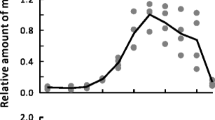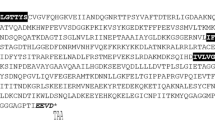Summary
Locusta migratoria adults reared at 27–30°C die after 2 h at 50°C, but they survive this temperature stress if first exposed to 45°C for 0.5 to 4.5 h. Fat bodies from adult females produce a set of at least six specific polypeptides with molecular weights of 81, 73, 68, 42, 28, and 24×103 in reponse to heat shock (39–47°C for 1.5 h). These molecular weights closely match those of the heat shock proteins (hsps) observed inDrosophila, with the possible exception of the 42 kd protein of locusts. The optimal temperature for induction of hsps in locusts is 45°C, which is one of the highest heat shock temperatures reported in metazoans. The correspondence between the optimal temperature for hsp induction and the temperature at which enhanced heat tolerance is acquired (both 45 °C) suggests that the hsps may be associated with thermal protection in these insects.
There appears to be no substantial translational control in the locust heat shock response, since other proteins are produced, albeit with some reduction, under heat shock conditions. Vitellogenin synthesis in fat bodies at 45°C is 55% of that observed at 30°C. The high optimal heat shock induction temperature and the continued synthesis of non-heat shock proteins may be adaptive to the locust's natural environment.
Similar content being viewed by others
References
Ashburner M (1982) The effects of heat shock and other stress on gene activity: an introduction. In: Schlesinger MJ, Ashburner M, Tissieres A (eds) Heat shock: from bacteria to man. Cold Spring Harbour Laboratory, Cold Spring Harbour, New York, pp 1–9
Ashburner M, Bonner JJ (1979) The induction of gene activity by heat shock. Cell 17:241–254
Burdon RH (1982) The human heat shock proteins: their induction and possible functions. In: Schlesinger MJ, Ashburner M, Tissieres A (eds) Heat shock: from bacteria to man. Cold Spring Harbour Laboratory, Cold Spring Harbour, New York, pp 283–288
Chen TT, Strahlendorf PW, Wyatt GR (1978) Vitellin and vitellogenin from locusts (Locusta migratoria). Properties and post-translational modification in the fat body. J Biol Chem 253:5325–5331
Chen TT, Couble P, Abu-Hakima R, Wyatt GR (1979) Juvenile hormone-controlled vitellogenin synthesis inLocusta migratoria fat body. Dev Biol 69:59–72
Dean RL, Atkinson BG (1982) The acquisition of thermal tolerance in larvae ofCalpodes ethlius and thein situ andin vitro synthesis of heat shock proteins. Can J Biochem Cell Biol 61:472–479
Fraenkel G, Hopf HS (1940) The physiological action of abnormally high temperatures on poikilothermic animals. Biochem J 34:1085–1091
Laemmli UK, Fauve M (1973) Maturation of the head of bacteriophage T4. J Mol Biol 80:575–599
Li GC, Werb Z (1982) Correlation between synthesis of heat shock proteins and development of thermotolerance in Chinese hamster fibroblasts. Proc Natl Acad Sci USA 79:3218–3222
Loomis WF, Wheeler SA (1980) Heat shock responses inDictyostelium. Dev Biol 79:399–408
Mitchell HK, Moller G, Petersen NS, Lipps-Sarmiento L (1979) Specific protection from phenocopy induction by heat shock. Dev Genet 1:181–192
Peterson GL (1983) Determination of total protein. In: Hirs CHW, Timasheff SN (eds) Methods in enzymology, vol 91. Academic Press, New York, pp 95–119
Phillips DR, Loughton BG (1979) The effect of inhibition of RNA and protein synthesis on the development of larvae ofLocusta migratoria. Insect Biochem 9:241–245
Skinner MK, Griswold MD (1983) Fluorographic detection of radioactivity in polyacrylamide gels with 2,5-diphenyloxazole in acetic acid and its comparison with existing procedures. Biochem J 209:281–284
Stephanou G, Alahiotis SN, Marmaras VJ, Christodoulou C (1983) Heat shock response inCeratitis capitata. Comp Biochem Physiol 74B:425–432
Uvarov B (1977) Grasshoppers and Locusts, a handbook of general acridology, vol 2. Centre of Overseas Pest Research, London
Weber K, Osborn M (1969) The reliability of molecular weight determination by dodecyl sulfate polyacrylamide gel electrophoresis. J Biol Chem 244:4406–4412
Wyatt GR, Chen TT, Couble P (1976) Juvenile hormone-induced vitellogenin synthesis in locust fat body in vitro. In: Kurstak E, Maramorosch K (eds) Invertebrate tissue culture — Application in medicine, biology, and agriculture. Academic Press, New York, pp 195–202
Author information
Authors and Affiliations
Rights and permissions
About this article
Cite this article
Whyard, S., Wyatt, G.R. & Walker, V.K. The heat shock response inLocusta migratoria . J Comp Physiol B 156, 813–817 (1986). https://doi.org/10.1007/BF00694255
Accepted:
Issue Date:
DOI: https://doi.org/10.1007/BF00694255




